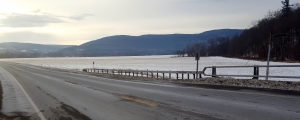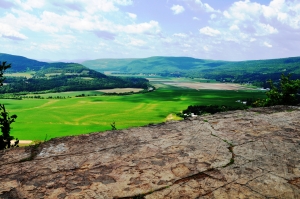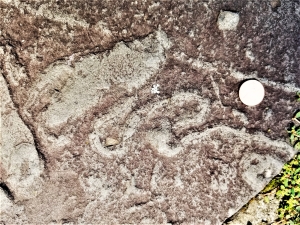The St. Peters slide 9-21-23
The St. Peters slide – an unhappy anniversary.
The Catskill Geologists
Robert and Johanna Titus
March 16, 2018
You remember that landslide on Nott Terrace in Schenectady in February, don’t you? We covered it right here in the Mountain Eagle. Well, it was just one of a number of landslides that have occurred in the Hudson Valley over the course of many years, even many millennia. The two of us have covered a number of them and that gives us a chance to be real conventional journalists. Who else can bring as much scientific understanding to the story as us? But logic and statistics tell you that there must have been a worst Hudson Valley landslide. There are usually two ways of estimating the magnitude of a slide. One is a measure of how many lives were lost; the other is in how much physical damage resulted. We are guessing that the terrible Haverstraw landslide of January of 1906 “wins” on both scores. A full six square city blocks of houses sank with that slide and 19 people died.
But another way of measuring the “worseness” of a landslide is in terms of its effect upon history. Our nominee for that category is celebrating its 159th anniversary this week. That’s the St. Peters College slide in the evening of St. Patrick’s Day, March 17th, 1859. We are not talking about St. Peters University in New Jersey, founded in 1872. This was an older St. Peters which was, in 1859, still being built. Ambitious plans had been underway; a five story building which would measure 200 feet in length was half constructed. It was a determined effort, and that St. Peters would have been a sizable college by the standards of its time. We wonder just how big would it have gotten?
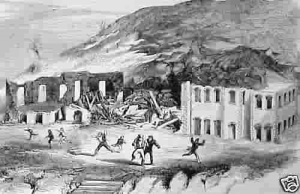
Old St. Peters College lay at the foot of Mt. Ida in the City of Troy. The slopes of that “mountain” rose slowly and gently behind the college. There was no apparent danger. But there were real similarities between Mt. Ida and Nott Terrace in Schenectady. Both sites lay within ice age deltas and that’s what generated the landslide threats. In Schenectady, the Mohawk River had once flowed into Glacial Lake Albany and deposited the delta that Schenectady came to be built on. In the then ice age Troy, Poesten Kill Creek flowed into the east side of the same lake and deposited the Mt. Ida Delta. In both cases the deltas were composed of sticky muddy sediments. When those get too wet, they become unstable and landslides become more and more likely. When Lake Albany drained away, both sites were left high and dry.
Nobody died at St. Peters, a number of children had been playing there just minutes ahead of time, but they had left. The college building was destroyed but it did block the slide from entering a residential community just a bit further downhill. Nevertheless St. Peters College had been destroyed and it was not possible to rebuild it; the money was just not there.
And that’s what makes this such a historic event. We have to ask “what would St. Peters College have become?” It surely would have grown into a very sizable university. Would it have had a powerhouse basketball team? What about its economic effect? Would Troy have become a far more affluent city with a large thriving university in it, lying close to RPI? We will never know the answers to such questions. But something very bad and very long lasting occurred on that night.
Contact the authors at randjtitus@prodigy.net. Join their facebook page “The Catskill Geologist.” Read their blogs at “thecatskillgeologist.com.”

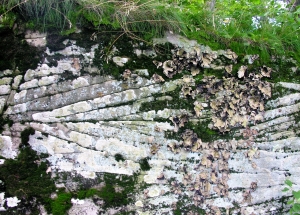
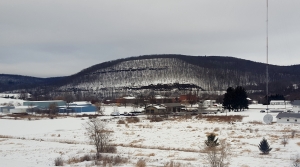
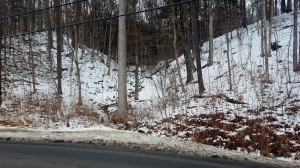
 W.M. Davis
W.M. Davis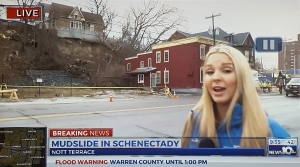
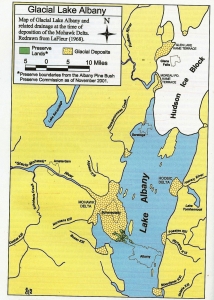
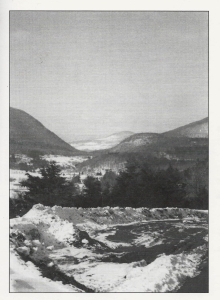 k at them. We found that the Roxbury 7 1/2 minute quadrangle map displayed the Gap. We found that the hump has a name; it is Jump Hill. Then we went back to our photo. The “hump” is actually something that lies in between two valleys. The contour lines on our map indicated a steep but steady slope for each of the two valleys. Each one of those is what geologists call a U-shaped valley. Every trained geologist on the planet Earth quickly recognizes the ice age history of such a valley. They record the passage of glaciers. As ice squeezed through a valley it ground away and eroded the bedrock. The shape that offers the least resistance is the U. Not surprisingly, over a period of time, glaciers will carve those U’s into the bedrock landscape. It gives each of them a path of least resistance. That forms a remarkably picturesque image and that helps make glaciated landscapes so attractive. We geologist are most fond of these U-shaped valleys.
k at them. We found that the Roxbury 7 1/2 minute quadrangle map displayed the Gap. We found that the hump has a name; it is Jump Hill. Then we went back to our photo. The “hump” is actually something that lies in between two valleys. The contour lines on our map indicated a steep but steady slope for each of the two valleys. Each one of those is what geologists call a U-shaped valley. Every trained geologist on the planet Earth quickly recognizes the ice age history of such a valley. They record the passage of glaciers. As ice squeezed through a valley it ground away and eroded the bedrock. The shape that offers the least resistance is the U. Not surprisingly, over a period of time, glaciers will carve those U’s into the bedrock landscape. It gives each of them a path of least resistance. That forms a remarkably picturesque image and that helps make glaciated landscapes so attractive. We geologist are most fond of these U-shaped valleys.